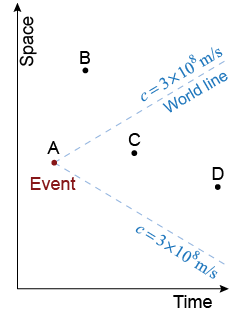|
The usual definition of simultaneous is “at the same time.” Because time is not constant for all observers, whether two events are simultaneous depends on the relative motion of the observers. Einstein proposed that the meaning of “simultaneous” is that two equidistant events are simultaneous if light from both events reaches the observer at the same time. The whole concept of “at the same time” depends on the relative motion of different observers. 
|
Einstein imagined two lightning strikes hitting the front and back of a moving train. You are the observer on the ground watching the train from a distance. Because you are the same distance from both strike points, you see the two bolts of lightning hit the train at the same time. To you, the two lightning strikes are simultaneous because it takes the same amount of time for light from either event to reach you. 
|

|
If the train were at rest, then the train rider would also observe two simultaneous lightning strikes. The train, however, is moving. The observer in the center of the train sees the front of the train hit first, and then the rear, so the two lightning strikes are not simultaneous. The speed of light is unaffected by the motion of the train. But the observer is moving toward the point where lightning struck the front of the train. Light from the front strike is seen first because that light has a shorter distance to travel to reach the observer. The rear strike is seen second because the observer is moving away from the point where that lightning struck. Light from the rear strike has a longer distance to go to and reaches the observer a nanosecond after light from the front strike. 
|
 Special relativity tells us that no information can travel faster than the speed of light. This has deep implications for cosmology, the study of the universe. The graph on the right shows space on the vertical axis and time on the horizontal axis. An event (A) occurs at a point in space and time. The world lines represent light spreading out at the speed of light. The event never exists for point (B) because light from (A) can never reach (B). Furthermore, point (D) experiences the event 1,000 years after point (C) because of the light travel time. To beings on a planet 165 million light years away, dinosaurs still live on Earth because that is the “now” they could see with their telescopes!
Special relativity tells us that no information can travel faster than the speed of light. This has deep implications for cosmology, the study of the universe. The graph on the right shows space on the vertical axis and time on the horizontal axis. An event (A) occurs at a point in space and time. The world lines represent light spreading out at the speed of light. The event never exists for point (B) because light from (A) can never reach (B). Furthermore, point (D) experiences the event 1,000 years after point (C) because of the light travel time. To beings on a planet 165 million light years away, dinosaurs still live on Earth because that is the “now” they could see with their telescopes! 
|
| |
|

